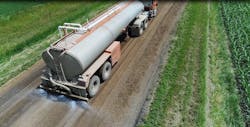Gravel road system in Minnesota county upgraded with base material stabilizer
In Wilkin County, Minnesota, Engineer Brian Noetzelman, P.E., and Assistant Engineer Steve Neppl have approximately 300 miles of gravel surfaced roads they maintain. Every year the county would spend money adding gravel that was lost due to weather, traffic, or snow removal, and had to spend hours on routine maintenance blading. Trying to maintain the county’s gravel roads up to the resident’s expectations proved to be a difficult task in such a highly agricultural area.
Years ago the county started to stabilize the gravel roads with Team Laboratory Chemical’s BASE ONE Liquid base stabilizer to enhance the properties of the aggregate material. This helped reduce maintenance and gravel loss and provided the residents with a much more desirable road system. The team had also completed quite a few full depth reclamation projects with 50% asphalt and 50% aggregate base blend where they incorporated the stabilizer, and the independent lab tests from these projects generated a much higher structural coefficient and resilient modulus number than the AASHTO standards for base material. Due to the success the team experienced with their stabilized full depth reclamation projects with the 50% asphalt and 50% aggregate material over the past few years, they decided to do a similar process on their aggregate surfaced County Road #17.
In 2016, County Road #17 was drain tiled down the center of the road. In 2018 a 1½-in. (approximately 1,000 ton per mile) of Class 5 modified aggregate material and 1½-in. (approximately 1,000 ton per mile) of bituminous millings were hauled in and mixed with approximately 1 in. of existing gravel. The entire 4-in. depth section of asphalt millings and aggregate material was mixed and stabilized with BASE ONE at the manufacturers at a rate of 0.005 gal per sq yd to inch in depth stabilized.
With the new stabilized material, Wilkin County is able to save on material loss and minimize the amount of blading required. County Road #17 only needed one light “brushing”, not a blading, the entire harvest season in 2018. Previous to that, the county was blading that roadway once if not twice per week to accommodate the fall harvest. The new mixture of aggregate, asphalt millings, and stabilizer became the favored solution for the county’s unsurfaced roads.
